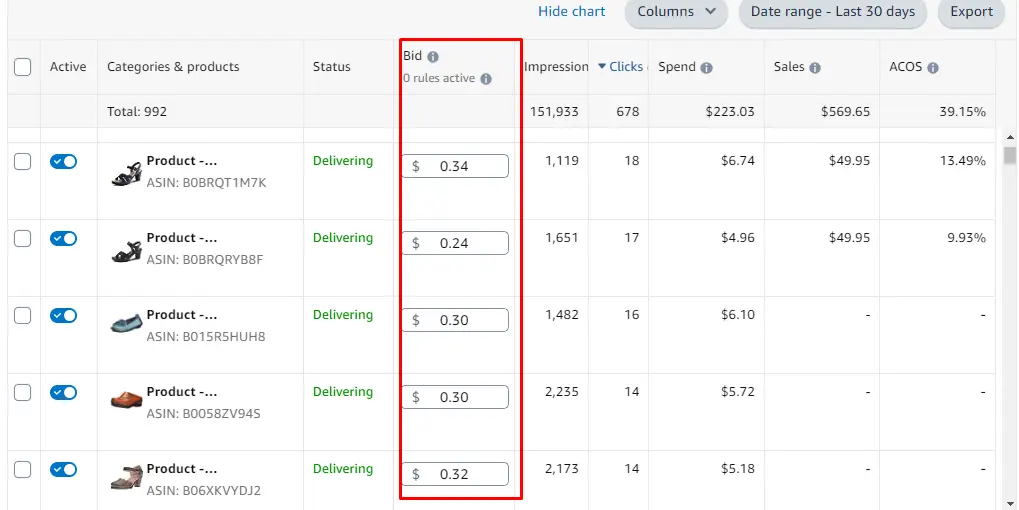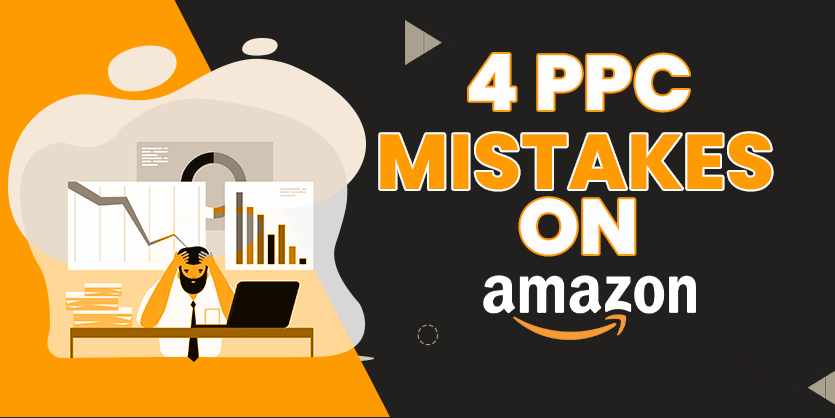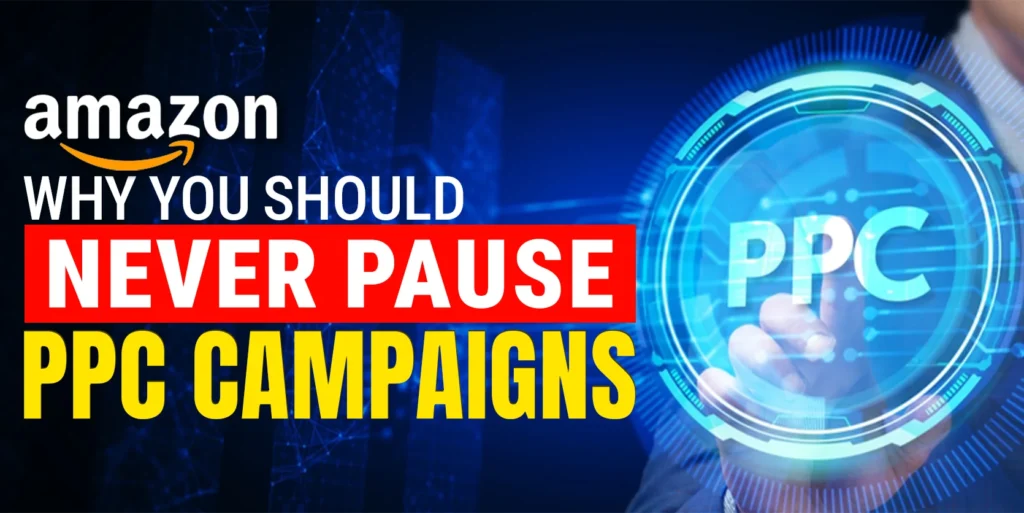Are you thinking about implementing an Amazon PPC (pay-per-click) strategy in your business? If so, you need to be aware of the typical Amazon PPC mistakes marketers make when using this type of Amazon advertising. There are many specific mistakes in PPC that impact Amazon PPC success. So, we need to understand the power and importance of an Amazon PPC. If a PPC strategy is not carefully thought out from start to finish, a business can end up wasting money or worse. In this post, we will see what sort of Amazon PPC mistakes are making your business less profitable and how you can overcome these issues.

How Amazon PPC Mistakes Cost You Money
It’s essential to be aware of common Amazon PPC mistakes that can destroy the success of your PPC campaigns. To be successful, Amazon PPC requires technical skills and experience. Obvious errors are rightly pointed out. By knowing and working on specific or potential errors, we can ensure that PPC stands a good chance and reaches its full potential. If you are not conscious of Amazon’s PPC mistake, you’ll end up paying for clicks that don’t result in sales, wasting your advertising budget. It will increase your CPC, and your ROI will be negative or very low, making your Amazon business less profitable.
From ad fraud to inaccurate targeting, several potential issues can impact the effectiveness of your Amazon PPC ads. Amazon PPC ads are an integral part of scaling your business. So without proper optimization and bidding, Amazon PPC mistakes can be very costly.
In this blog, we will discuss four of these Amazon PPC mistakes. Some of these PPC errors are obvious, while others lead to hidden problems that hinder optimal performance.
Amazon PPC Mistake 1: Neglecting Keywords
Many people create automated campaigns, discovery campaigns, or general campaigns and when they see that a search term with a lower ACOS is selling well, they simply cancel it and create an entirely new campaign with an exact match type.
This is a terrible Amazon PPC mistake. Because this broad match campaign will almost certainly have a Lower ACOS than the exact match campaign and already contains data. 
If your top-performing keywords have low search volume, creating a separate exact-match campaign may result in limited traffic. This can reduce the visibility of your ads and limit potential conversions. Managing multiple campaigns with different match types for the same keywords can be complex and time-consuming. Additional tracking, monitoring, and optimization efforts may be required. Exact match keywords often have higher CPCs than broad match or discovery keywords. Splitting these keywords into a separate campaign may increase your overall campaign costs.
If something works well and has data, leave it. Don’t mess with this because you don’t know if it will work better with an exact match and how long it will take to get better results.
Amazon PPC Mistake 2: Negations Once a Week
A classic mistake in Amazon PPC is to spend the most on irrelevant search terms or any keywords that do not perform well. Adding Negative Keywords is one of the most important things needed in any PPC account. Negative keywords are used to filter out irrelevant search terms and ensure that your ads appear only for the specific keywords you want to target. By maintaining a well-defined negative keywords list, you can optimize your ad campaigns to appear for the most relevant and valuable search queries.
We often focus on increasing or decreasing keyword bids to get more conversions. When you add negative keywords to your account, it helps platforms redirect our budget to effective keywords and avoid showing ads with irrelevant terms. This tactic is a piece of the Amazon PPC optimization puzzle that typically delivers a positive ROI.
To avoid the Amazon PPC mistakes of neglecting to add negative keywords weekly, it’s important to establish a process for monitoring your PPC campaigns. This process should include analyzing search term reports, identifying irrelevant search terms, and adding negative keywords to your list.
Amazon PPC Mistake 3: Turning Off Old Campaigns
Avoid the mistakes in PPC of turning off old campaigns and creating completely new ones. If you turn off all of the campaigns you will lose all the historical data from your old campaigns. It helps you make informed decisions about keywords, targeting, and bidding. Older campaigns often contain lists of keywords that have been tested and refined over time.
You can use these lists in new campaigns, saving time and effort on keyword research. Legacy campaigns provide insights into audience behavior and preferences. You can identify patterns and trends in user interactions, allowing you to refine your audience targeting and messaging for better results.
When you create a brand new campaign it takes at least three – four weeks to come into themselves. Because Amazon needs data first to see some sales, you need sales to get sales on Amazon. We are showing you the difference between data, turning Off Old campaigns, and creating new Campaigns.
Old campaigns are valuable because they provide a treasure trove of data, information, and resources that can inform and improve your current and future advertising efforts. So, instead of destroying all of the old campaigns please organize them.
Amazon PPC Mistake 4: Campaigns Budget vs. Bid
Another common Amazon PPC mistake is to limit the campaign’s budget without fixing the bids. Many sellers first check the campaign’s status, if the campaign performance becomes bad then they cut off the budget. It’s one of the big Amazon PPC mistakes of cutting off the budget instead of bid. Because in this situation you will miss many opportunities.
When you limit campaigns by budget, you risk losing impressions and clicks. If your campaigns consistently finish your budget early in the day, your ads will stop running for the rest of the day, which can result in a loss of valuable traffic and conversions. Important keywords that drive effective conversions may be dropped prematurely, impacting your overall ROI. 
Your competitors can bid better on ad placement if they are not constrained by budget constraints. This can cause your ads to rank lower. If your Amazon advertising goals are to expand campaigns to reach a wider audience, budget constraints can be a major obstacle. You may need to constantly adjust and increase your budget to accommodate growth, which can be difficult to manage.
While limiting campaigns by budget allows you to control ad spend, it can lead to reduced visibility, missed opportunities, and inefficient spending. So, If any campaign performance becomes bad don’t go off the budget first check the bid and adjust properly. Regularly review and adjust your bidding strategies to ensure that you’re maximizing the performance of your top-performing keywords while staying within your budgetary limits.
Insights!
In the entire post, we have seen how Amazon PPC mistakes can cost you sales and make you less profitable. We have gone through the notion of how you can avoid these common PPC mistakes. By focusing on reaching your targets in the right place, delivering the right message for your campaign’s specific goal, and tracking results every step of the way, you can keep people’s expectations in mind and optimize your campaign accordingly.
Hopefully, you’ve learned a few things and will avoid these common Amazon PPC mistakes. If you’re afraid you’re wasting money or just want a second set of eyes to take a look at your campaign and offer suggestions, we’re always available to lend a helping hand. If you need help with your campaign or are curious about learning more, please feel free to reach out to us at our email address info@ecomclips.com



